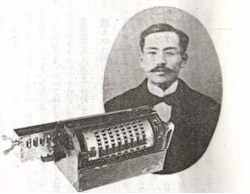History of Computers - Yazu Arithmometer
--Rbeckner 09:19, 10 September 2010 (CDT)
The Yazu Arithmometer was a mechanical calculator developed by Ryoichi Yazu of Buzen, Japan in 1903. It is notable because it is essentially a mechanized version of the Japanese abacus (the soroban)[1].

Construction and Capabilities
The Yazu Arithmometer is constructed out of 22 gears and a single metal cylinder. The Yazu Arithmometer was capable of calculations up to 16 digits and had an automatic carry function[2]. The Yazu Arithmometer provided a stable calculation tool to those already familiar with the methods required to use the soroban (the soroban uses two types of beads during calculations, one type of bead representing one, the other type of bead representing five)[3]. Because of their high cost, only about 200 were made and sold to Japanese government agencies.
Today
The Yazu Arithmometer is largely obsolete today due to the pocket electric calculator. The Although the Arithrometer may not be relevant, the soroban is still widely used in Japan as a teaching aid[4]. In 2008, the Yazu Arithmometer was added to the Mechanical Engineering Heritage, a collection of the greatest classical mechanical engineering feats of Japan[5].
Links
http://en.wikipedia.org/wiki/Ry%C5%8Dichi_Yazu
http://www.xnumber.com/xnumber/japanese_calculators.htm
References
- ↑ http://www.xnumber.com/xnumber/japanese_calculators.htm
- ↑ http://en.wikipedia.org/wiki/Ry%C5%8Dichi_Yazu
- ↑ http://hst250.history.msu.edu/wiki-online/index.php/Ry%C5%8Dichi_Yazu/Yazu_Arithmometer
- ↑ http://en.wikipedia.org/wiki/Soroban
- ↑ http://en.wikipedia.org/wiki/Mechanical_Engineering_Heritage_%28Japan%29